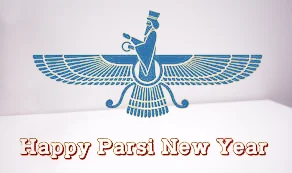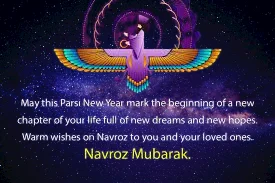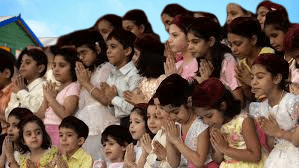Parsi New Year: Navroz, also known as Nowruz or Parsi New Year, marks the beginning of spring and the renewal of nature and is celebrated by different cultures and communities around the world, including in India but many remain confused about the date of the festival as it is celebrated twice a year in India. The festival of Navroz or Jamshed-i-Navroz/Jamshed-i-Nouroz is named after the Persian king, Jamshed, who is credited for creating the Persian or the Shahenshahi calendar and as per the legend, Jamshed saved the world from an apocalypse that came in the form of a winter and destined to kill everyone.

Parsi New Year 2023
Parsi New Year is a regional holiday celebrated on August 16th in India. The date varies year to year. In 2023, it is celebrated on 16th August.
It is also known as ‘Jamshedi Navroz’ after the legendary King of Persia, Jamshed who started the Parsi Calendar and Navroz meaning ‘new day’.
History of Parsi New Year
Parsis follow the religion of Zoroastrianism, one of the oldest known monotheistic religions. It was founded by the Prophet Zarathustra in ancient Iran approximately 3,500 years ago.
It was one of the ancient world’s most important religions for over 1000 years and was the official religion of Persia (now Iran) from 650 BCE until the rise of Islam in the 7th century.
When the Islamic armies invaded Persia, many Zoroastrians migrated, to places such as Gujarat in India and Pakistan. Nowadays there are an estimated 2.6 million Zoroastrians worldwide, with the Parsis (‘Parsi’ being Gujarati for Persian) in India being the largest single group.
In Iran and other parts of the Middle East, Zoroastrians celebrated the Persian New Year using the Fasli/Bastnai calendar, which fixed the first day of the year on the Spring Equinox, usually March 21st. To this day, this remains a popular festival, known as Nowruz, celebrated by many peoples and cultures in the region, despite not being Zoroastrians.
The Parsis however, observe the new year using the Shahenshahi calendar which does not account for leap years, meaning this holiday has now moved by 200 days from its original day of the vernal equinox.

The most prominent Navroz celebrations take place in Maharashtra and Gujarat in India on account of a sizeable Parsi population living in the two states but though celebrated in March globally, Navroz arrives 200 days later in India and is celebrated in the month of August as the Parsis here follow the Shahenshahi calendar that doesn’t account for leap years. Interestingly in India, people celebrate it twice a year – first according to the Iranian calendar and the second according to the Shahenshahi calendar which is followed by people here and in Pakistan.
Hence, the Parsi New Year i.e. the festival of Navroz falls between July and August where ‘Nav’ in Persian stands for ‘new’ while ‘Roz’ means ‘day’ that literally translates to ‘new day’ and this year, Parsi New Year will be observed in India on August 16. This tradition of celebrating Parsi New Year is believed to have been observed by Iranians and Zorastian for the past 3,000 years as it marks the beginning of the Iranian calendar and is celebrated till date by the Parsi community around the world with great pomp and show.
The auspicious festival of Navroz which is also known as Nowruz, falls in India in the month July or August. This year Parsi New Year will be observed today i.e. on 16 August. The Parsi community in India follows the Shahenshahi calendar, due to which they observe Navroz nearly about 200 days after the rest of the world. Globally, Parsi New Year falls in the month of March.
Parsi New Year 2023 Wishes
1 – Wish you and your family a joyous year, may your life be filled with joy, achievements, and wellness. Navroz Mubarak
2 – May love, bravery, wisdom, patience, be by your side this year.
3 – May this year bring lot of happiness and prosperity to you and your family
4 – Saal Mubarak! May this year bring you and your family joy, success and good health.
5 – May this year be a fresh chapter filled with new ambitions, goals and success. Navroz Mubarak
6 – May your life bloom with joy, happiness and success just as flowers with arrival of Spring
7 – Saal Mubarak! Wish the coming year is filled with compassion, togetherness for you and your loved ones.
8 – On this auspicious day, wish you and your loved ones achieve fulfillment they deserve in the coming year. Navroz Mubarak
9 – Wish this radiant rays of Navroz lead you and your family to new beginnings
10 – Saal Mubarak! May the coming 12 months be full of contentment, peace for you and your family.
Parsi New Year or Navroz preparations begin with a focus on celebrating the renewal that a new year brings such as house cleaning, wearing new clothes, giving gifts, and making charitable donations. People visit the temples to offer prayers and relish Parsi dishes such as Farcha, Egg Patties, Mithu Dahi, Sali Boti, and Jardaloo Chicken. People greet each other with Parsi New Year wishes of good fortune and health.
On this day, Parsis clean the house and decorate it with flowers and rangoli to make it look beautiful and welcoming for visitors. Dressed up in traditional attire, they visit the Fire Temple after breakfast and perform a prayer called Jashan to express gratitude to the Lord, pray for prosperity, and seek His forgiveness. Milk, water, fruits, flowers, and sandalwood are put into the sacred fire as offerings.

Guests are welcomed with a sprinkling of rose water,offered Faluda to drink and exchange Navroz Mubarak wishes. Also, people often mark the Parsi New Year celebrations by giving charitable donations to the poor.
India is known for its culture, diversity, and tradition. One of the traditions is Parsi New Year which is celebrated by the Parsi people. Parsi New Year is also known as Persian New Year. Not only in India Persian New Year is celebrated globally. UNESCO in 2010 declared Persian New Year an intangible cultural heritage of humanity. The root of the Persian New Year is 3000 years old.
40 Facts on Parsi New Year
- Parsi New Year, or Navroz, is celebrated by the Parsi community, primarily in Iran, India, and other parts of South Asia.
- The term “Navroz” translates to “new day” in Persian.
- The festival marks the beginning of the Parsi calendar year and usually falls on the spring equinox, around March 20th or 21st.
- The Parsi calendar is based on the ancient Zoroastrian calendar, which originated in Persia.
- Zoroastrianism is one of the world’s oldest monotheistic religions, and Parsis are followers of this faith.
- The festival celebrates the rejuvenation of nature, symbolizing the triumph of good over evil and the arrival of spring.
- Houses are traditionally cleaned and decorated before Navroz as a way to welcome the new year.

- People wear new clothes and gather to offer prayers and seek blessings.
- Haft-Seen, a traditional table setting, is prepared with seven symbolic items that start with the Persian letter “S,” each representing a different aspect of life.
- Parsis engage in philanthropic activities and give back to their communities during this time.
- Special dishes are prepared for the occasion, such as “Parsi Pulao” and “Sali Boti.”
- Families come together for festive meals and share traditional foods.
- Parsi children often receive gifts and tokens of love from their elders.
- Flowers are an integral part of Navroz celebrations, symbolizing renewal and growth.
- Some Parsis visit fire temples to pray and offer their respects.
- The “Pateti” is the day preceding Navroz, observed as a time of reflection and repentance.
- Navroz is a public holiday in Iran and several Indian states like Gujarat and Maharashtra.
- The Parsi community in Mumbai holds a grand parade known as the “Navroz Procession.”
- Cultural performances, music, and dance are important components of Navroz celebrations.
- The festival emphasizes unity, harmony, and respect for all living beings.
- Parsis often extend invitations to friends and neighbors to join in the celebrations.
- Parsi New Year is also celebrated by Zoroastrian communities in other parts of the world.
- The Navroz festival is deeply rooted in the rich history and traditions of Zoroastrianism.
- Traditional rituals and prayers are performed by Parsi priests during the celebrations.
- Many Parsis engage in acts of charity and volunteer work during this time.
- The day holds cultural significance as it marks the rebirth of the world after the cold winter months.
- It’s a time for families to come together and strengthen their bonds.
- Navroz is not just a religious festival; it’s also a celebration of cultural heritage.
- Parsi New Year is an occasion to appreciate the beauty of life and the wonders of nature.
- The festival is a reminder of the Parsi community’s resilience, values, and contributions to society.
- Navroz holds deep historical roots, tracing back over 3,000 years to ancient Persia.
- The Parsi community in India observes Navroz with great enthusiasm, often participating in special events and parades.
- On Navroz, Parsis visit the Fire Temple to offer prayers, symbolizing purity and light.
- The festival is also known as “Jamshedi Navroz” in honor of King Jamshed, who introduced the Zoroastrian calendar.
- Navroz is not only celebrated by Parsis but also by various other communities influenced by Zoroastrianism.
- “Shahenshahi Navroz” is another variant celebrated by some Parsis, observed a day after the spring equinox.
- Traditional music and dance performances play a crucial role in Navroz celebrations, reflecting the community’s artistic heritage.
- A festive dish called “Ravo” is often prepared, made from semolina and garnished with nuts and dried fruits.
- Navroz aligns with the philosophy of renewal, inspiring individuals to reflect on personal growth and self-improvement.
- The colorful rangoli patterns known as “rangoli-e-saale” are a prominent feature in Parsi households during Navroz, adding to the festive atmosphere.
For more interesting articles from the “GENERAAL AWARENESS SECTION” CLICK HERE.